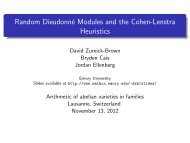alternative lecture notes - Rational points and algebraic cycles
alternative lecture notes - Rational points and algebraic cycles
alternative lecture notes - Rational points and algebraic cycles
Create successful ePaper yourself
Turn your PDF publications into a flip-book with our unique Google optimized e-Paper software.
Proof. It suffices to check that const preserves fibrations <strong>and</strong> trivial fibrations. This follows<br />
simply from the definition of projective model structure. If f is a fibration, then const(f)<br />
is level-wise just f. Since it is level-wise a fibration, it is a fibration in the projective model<br />
structure. Similarly for trivial fibrations.<br />
□<br />
Dually, the functors const <strong>and</strong> lim define a Quillen adjunction between M <strong>and</strong> M D endowed<br />
with the injective model structure:<br />
const: M<br />
M D : lim<br />
Theorem 11.2. Let C, D be Grothendieck sites <strong>and</strong> f : D → C a morphism of sites. Let<br />
Sh(D) ∆op <strong>and</strong> Sh(C) ∆op be the categories of simplicial sheaves of abelian groups on D <strong>and</strong><br />
C, both endowed with the Joyal model structure. Then<br />
is a Quillen adjunction.<br />
f ∗ : Sh(D) ∆op<br />
Sh(C) ∆op : f ∗<br />
Example 11.3. Let D be the trivial site (i.e. the Zariski site of the empty set). Then Sh(D)<br />
is Set. Theorem 11.2 says that, for any site C, we get a Quillen adjunction<br />
Γ ∗ : Set ∆op<br />
Sh(C) ∆op : Γ ∗<br />
where Γ ∗ = const is taking the constant sheaf <strong>and</strong> Γ ∗ is taking global sections.<br />
Example 11.4. Let D be as in Example 11.3. Let C be a category endowed with the trivial<br />
Grothendieck topology. This means that the covering families are the isomorphisms. The<br />
sheaf condition now becomes vacuous. Then all presheaves are sheaves, so that Sh(C) =<br />
Set C , <strong>and</strong> Sh(C) ∆op = (Set ∆op ) C . Now the Joyal model structure on Sh(C) ∆op coincides<br />
with the injective model structure on (Set ∆op ) C . The Quillen adjunction takes the form<br />
const: Set ∆op<br />
(Set ∆op ) C : lim<br />
where the functor on the right is taking the limit over C.<br />
We briefly explain why the Joyal model structure <strong>and</strong> injective model structure on Sh(C) ∆op<br />
coincide when C has the trivial topology. For this, we may check that the cofibrations <strong>and</strong><br />
weak equivalences coincide. In both model structures, the cofibrations are the levelwise <strong>and</strong><br />
objectwise injective maps. One can further show that the topology being trivial implies that<br />
the level-wise weak equivalences coincide with the stalk-wise weak equivalences.<br />
Example 11.5. Let M be a simplicial model category <strong>and</strong> let C ∈ M be a cofibrant object.<br />
Then there is a Quillen adjunction between SSet <strong>and</strong> M:<br />
• × C : SSet<br />
M : Map(C, •)<br />
This is simply a restatement of the fact that M is copowered over SSet.<br />
Dually:<br />
Example 11.6. Let M be a simplicial model category <strong>and</strong> let F ∈ M be a fibrant object.<br />
Then there is a Quillen adjunction between SSet <strong>and</strong> the opposite category of M:<br />
F • : SSet<br />
M op : Map(•, F )<br />
This is simply a restatement of the fact that M is powered over SSet.<br />
25



